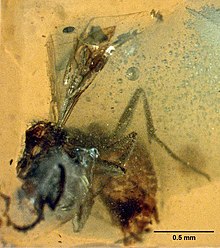Haidomyrmodes
| Haidomyrmodes Temporal range:
| |
|---|---|

| |
| Haidomyrmodes mammuthus holotype gyne | |
| Scientific classification | |
| Domain: | Eukaryota |
| Kingdom: | Animalia |
| Phylum: | Arthropoda |
| Class: | Insecta |
| Order: | Hymenoptera |
| Family: | Formicidae |
| Subfamily: | †Haidomyrmecinae |
| Genus: | †Haidomyrmodes Perrichot et al, 2008 |
| Species: | †H. mammuthus
|
| Binomial name | |
| †Haidomyrmodes mammuthus Perrichot et al, 2008
| |
Haidomyrmodes is an
History and classification
Haidomyrmodes is known from a group of three fossils, the
Paris, France. The holotype specimen is composed of a mostly complete winged adult female, while the paratypes are both of incomplete worker caste members. All of the specimens are preserved as inclusions[1] in transparent chunks of Late Albian to Early Cenomanian Charentese amber found in the Charente-Maritime area of France.[2]
Naturwissenschaften. The genus name Haidomyrmodes was coined by Perrichot et al as a combination of Haidomyrmex, the type genus for Haidomyrmecini, and the suffix -odes meaning "with the form of". The specific epithet mammuthus is a reference to the resemblance between the species' mandibles and the tusks of a mammoth.[1] Haidomyrmodes is one of five genera in Haidomyrmecini, the other four being Ceratomyrmex, Linguamyrmex, Haidomyrmex, and Haidoterminus.[3][1][4]
Description
The Haidomyrmodes holotype
ocelli and large eyes. The clypeus has a concave structure to it in side view and without and setae. In contrast the two paratype specimens, identified as possible worker caste individuals, differ in the structure from the gyne in several ways. Overall they are smaller than the gyne, and have a basal mandible section shorter than that of the gyne, with two long setae and antennae which are shorter.[1]
References
- ^ S2CID 19130572. Archived from the original(PDF) on 2013-04-25.
- PMID 23317048.
- .
- S2CID 53993056.
External links
 Media related to Haidomyrmodes mammuthus at Wikimedia Commons
Media related to Haidomyrmodes mammuthus at Wikimedia Commons
